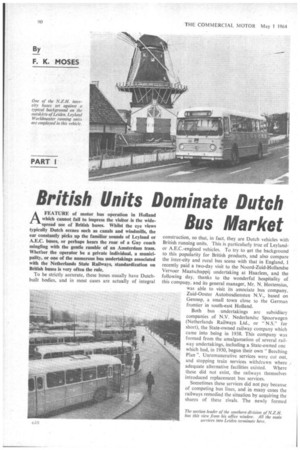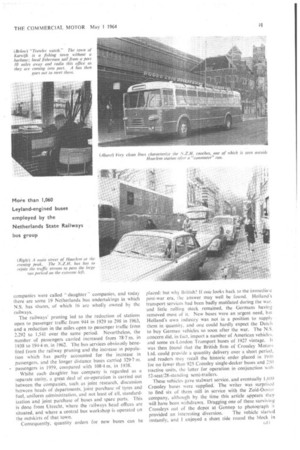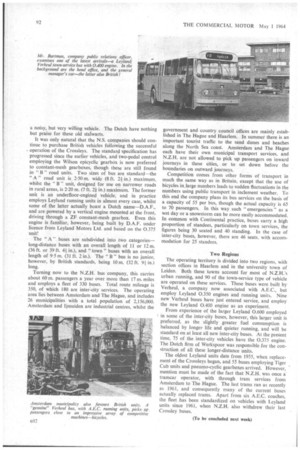British Units Dominate Dutch Bus Market
Page 92

Page 93

Page 94

If you've noticed an error in this article please click here to report it so we can fix it.
By F. K. MOSES
AFEATURE of motor bus operation in Holland which cannot fail to impress the visitor is the widespread use of British buses. Whilst the eye views typically Dutch scenes such as canals and windmills, the ear constantly picks up the familiar sounds of Leyland or A.E.C. buses, or perhaps hears the roar of a Guy coach mingling with the gentle rumble of an Amsterdam tram. Whether the operator be a private individual, a municipality, or one of the numerous bus undertakings associated with the Netherlands State Railways, standardization on British buses is very often the rule.
To be strictly accurate, these buses usually have Dutchbuilt bodies, and in most cases are actually of integral construction, so that, in fact, they are Dutch vehicles with British running units. This is particularly true of Leylandor A.E.C.-engined vehicles. To try to get the background to this popularity for British products, and also compare the inter-city and rural bus scene with that in England, I recently paid a two-day visit to the Noord-Zuid-Hollandse Vervoer Maatschappij undertaking at Haarlem, and the following day, thanks to the wonderful hospitality of this compauy. and its general manager, Mr. N. Hortensius, was able to visit its associate bus company, Zuid-Ooster Autobusdiensten N.V., based on Gennep, a small town close to the German frontier in south-east Holland.
Both bus -undertakings are subsidiary companies of N.V. Nederlandse Spoorwegen (Netherlands Railways Ltd., or "N.S." for short), the State-owned railway company which came into being in 1938. This company was formed from the amalgamation of several railway undertakings, including a State-owned one which had, in 1930, begun their own " Beeching Plan ". Unremunerative services were cut out, and stopping train services withdrawn where adequate alternative facilities existed. Where these did not exist, the railways themselves introduced replacement bus services.
Sometimes these services did not pay because of competing bus lines, and in many cases the railways remedied the situation by acquiring the shares of these rivals. The newly formed companies were called daughter companies, and today there are some 19 Netherlands bus undertakings in which M.S. has shares, of which 16 are wholly owned by the railways.
The railways' pruning led to the reduction of stations open to passenger traffic from 944 in 1929 to 298 in 1963, and a reduction in the miles open to passenger traffic from 2,292 to 1,541 over the same period. Nevertheless, the number of passengers carried increased from 78.7 in. in 1938 to 1944. m. in 1962. The bus services obviously benefited from the railway pruning and the increase in population which has partly accounted for the increase in passengers, and the longer distance buses carried 329-7 m. passengers in 1959, compared with 108-4 m. in 1938.
Whilst each daughter bus company is regarded as a separate entity, a great deal of co-operation is carried out between the companies, such, as joint research, discussion between heads of departments, joint purchase of tyres and fuel, uniform administration, and not least of all, standardization and joint purchase of buses and spare parts. This is done from Utrecht, where the railways head offices are situated, and where a central bus workshop is operated on the outskirts of that town.
Consequently, quantity orders for new buses can be
placed: but why British? If one looks back to the' immediate post-war era, the answer may well be found. Holland's transport services had been badly mutilated during the war, and little rolling stock remained, the Germans having removed most of it. New buses were art urgent need, but Holland's own industry was not in a position to supply. them in quantity, and one could hardly expect the Dutch to buy German vehicles so soon after the war. The N.S. concern did, in fact, import a number of American vehicles, and some ex-London Transport buses of 1927 vintage. It was then found that the British firm of Crossley Moto s Ltd. could provide a quantity delivery over a short period, and readers may recall the historic order placed in 1946 for no fewer than 925 Crossley single-decker buses and 250 tractive units, the latter for operation in conjunction with 52-seat/28-standing semi-trailers.
These vehicles gave stalwart service, and eventually 1,600 Crossley buses were supplied. The writer was surprised to find six of them still in service with the Zuid-Ooster company, although by the time this article appears they will have been withdrawn. Dragging one of these surviving Crossleys out of the depot at Gennep to photograph it provided an interesting diversion. The vehicle started instantly, and 1 enjoyed a short ride round the block in a noisy, but very willing vehicle. The Dutch have nothing but praise for these (Ad stalwarts.
It was only natural that the N.S. companies should continue to purchase British vehicles following the successful • operation of the Crossleys. The standard specification has progressed since the earlier vehicles, and two-pedal control employing the Wilson epicyclic gearbox is now preferred to constant-mesh gearboxes, though these are still found in "-B road units. Two sizes of bus are standard—the " A " road unit is 2-50 m. wide (8 ft, 24 in.) maximum, whilst the "B " unit, designed for use on narrower roads in rural areas, is 2-20 m. (7 ft. 2i in.) maximum. The former unit is an underfloor-engined vehicle, and in practice employs Leyland running units in almost every case, whilst some of the latter actually boast a Dutch name--D.A.F., and are powered by a vertical engine mounted at the front, driving through a ZF constant-mesh gearbox. Even this engine is familiar, however, being built by D.A.F. under licence from Leyland Motors Ltd. and based on the 0.375 unit!
• The A " buses are subdivided into two categories— long-distance buses with an overall length of 11 or 12 m. (36 ft. or 39 ft. 41 in.), and " town" buses with an overall length of 9.5 in. (31 ft. 2 in.). The " B " bus is no junior, however, by British standards, being 10 m. (32 ft. 91 in.) long.
Turning now to the N.Z.H. bus company, this carries about 60 m. passengers a year over more than 17 m. miles and employs a fleet of 330 buses. Total route mileage is 350, of which 180 are inter-city services. The operating arealies between Amsterdam and The Hague, and includes 26 municipalities with a total population of 2,156,000. Amsterdam and Ijmuiden are industrial centres, whilst the government and country council offices are mainly established in The Hague and Haarlem. In summer there is an important tourist traffic to the sand dunes and beaches along the North Sea coast. Amsterdam and The Hague each have their own municipal transport services, and N.Z.H. are riot allowed to pick up passengers on inward journeys in these cities, or to set down before the boundaries on outward journeys.
Competition comes from other forms of transport in much the same way as in Britain, except that the use of bicycles in. large numbers leads to sudden fluctuations in the numbers using public transport in inclement weather. To this end the company plans its bus services on the basis of a capacity of 55 per bus, though the actual capacity is 65 to 70 passengers. In this way such " emergencies " as a wet day or a snowstorm can be more easily accommodated. In common with Continental practice, buses carry a high proportion of standees, particularly on town services, the figures being 30 seated and 40 standing. In the case of inter-city buses, however, there are 46 seats, with accommodation for 25 standees.
Two Regions The operating territory is divided into two regions, with section offices in Haarlem and in the university town of Leiden. Both these towns account for most of N.Z.H.'s urban running, and 90 of the town-service type of vehicle are operated on these services. These buses were built by Verheul, a company now associated with A.E.C., but employ Leyland 0.350 engines and running units. Nine new Verheul buses have just entered service, and employ the new Leyland 0.400 engine as an experiment. From experience of the larger Leyland 0.600 employed i in some of the inter-city buses, however, this larger unit is preferred, as the slightly greater fuel consumption is balanced by longer life and quieter running, and will be standard on at least all new inter-city buses. At the present time, 75 of the inter-city vehicles have the 0.375 engine. The Dutch firm of Werkspoor was responsible for the construction of all these longer-distance units.
The oldest Leyland units date from 1955, when replacement of the Crosskys began, and 55 buses employing Tiger Cub units and pneurno-cyclic gearboxes arrived. However, mention must be made of the fact that N.Z.H. was once a tramcar operator, with through tram services from Amsterdam to The Hague. The last trams ran as recently as 1961, and consequently many of the current buses actually replaced trams. Apart from six A.E.C. coaches, the fleet has been standardized on vehicles with Leyland units since 1961, when •N.Z.H. also withdrew their last Crossley buses.
(To be concluded next week)




















































































































































































































































